
REVIEW
Joe Sacco
Fantagraphic Books
$24.95/Softcover
Revealing the Palestinian Experience
By Maureen Murphy
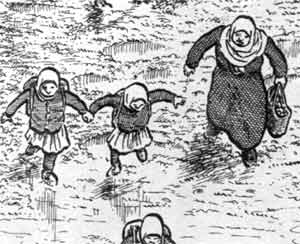
In the U.S. press, readers rarely see the faces of displaced Palestinians living within refugee camps or hear the individual stories of
Palestinian men and women who are unable to get to their jobs because of military checkpoints. Lost in major news stories are the scores
of young men who have served over a year in prison for violating an 8:00 p.m. curfew, and rarely do Americans see the tree stumps from
razed olive tree orchards (these being a major staple of what was the Palestinian economy) and the ghettoized neighborhoods in which
families must raise their children.
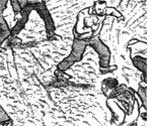
Perhaps this lack of "human" information - that which is beyond casualty statistics - is a fault of the newspaper medium. It is expensive
and time consuming for a major publication to send a journalist, be it reporter or photographer, to gather these stories when the Associated
Press (AP) provides what is usually printed: the faces of suicide bombers and militants, the numbers of Israelis killed or injured (almost
always mentioned before that of Palestinians, especially when it comes to children), and how Prime Minister Sharon and his right-wing party
plan to respond.
Journalist Joe Sacco solves this problem of lack of human context in Palestine, a 285-page comic book. Through a format traditionally
associated with fantasy illustration and narration, Sacco finds the balance between the potent images and text necessary to enable a
historical and cultural understanding of the Israeli-Palestinian conflict.

Palestine, which documents the author's two-month stay during late 1991 and early 1992 in various occupied territories, offers the
stories of several individuals and families who have suffered during the first intifada. Readers meet many conflict-weary Palestinians
who, despite their chronic unemployment, are more than hospitable to the American journalist and eager to have their stories told overseas.
One of these families "invites us in ... As usual, all the time is tea time, and there's chocolates left over from the Greek Orthodox Christmas."
The mother tells of an Israeli settler accusing her son (no older than 15) of throwing stones at his car, prompting Israeli soldiers to beat him
in his home. The boy's grandfather tears up as he recounts the day Israeli soldiers forced him to cut down his olive trees himself after a molotov
cocktail was thrown from his orchard. Sacco asks "How did it feel?" To which the elderly man replies, "I was crying. I felt I was killing my
son when I cut them down."
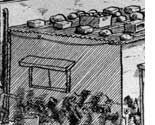
Sacco puts this story in perspective as the cartoon frame depicts the journalist getting into a car with the family, giving him their farewell
s, among the aforementioned tree stumps. "And his is just a teardrop in the bucket ... Six Palestinian trees? 17? 70? Pfft! The Israelis
uprooted 120,000 plus in the intifada's first four years. ... for 'security reasons' like in these cases ... or in constructing the network
of roads that link Jewish settlements to Israel... ."
Some of the book's more violent images are found in the chapter "Ansar III." Sacco describes Ansar III as Israel's largest prison, "holding 6,000
inmates as of Nov. '91. It opened in March '88 specifically to deal with the intifada overflow ... ." An Ansar "alumna," as they are frequently
referred to in the book, describes the inhumane conditions of the camp. One of the rooms " ...was 3x4 meters, with 21 persons. The metal door
faced the sun from noon on. The ventilation was very bad, just a coin-sized hole in the door for injecting gas in case of a riot."
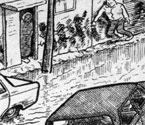
This kind of treatment in prison was not reserved just for men. A young woman, arrested "for something she says she didn't do - underwriting
nationalistic pamphlets," tells how " ...in the Russian Compound the Shin Bet stood her up in the 'coffin' half a day after she'd undergone
a liver biopsy... . '[The coffin is] a small closet, you stand up in it, it's 80x60 cm, two meters high, very dark... ." Sacco continues
"But worst of all was isolation, her cell, which was besmirched with filth, she says, and where she was left without toilet paper and
sanitary napkins... ."
The gritty images of prison cells and Palestinian homes with sand for floors are in a later chapter contrasted by the bright images of
Jerusalem and Tel Aviv. Sacco debates politics with two young Tel Aviv architects (who happen to be women) in an outdoor cafe framed by
high rise resorts. When Sacco asks "What about when Palestinians take military action against the occupation forces? Do they have that
right at all?," one of the women angrily responds, "We just want to live our lives, okay? We have our lives! We have jobs and families
and we go out and live just like you do ... We don't think about this stuff all the time, and we get a bit tired of hearing about it!"
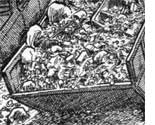
Although it may be easier for Americans not to hear about the military occupation in Palestinian territories and the civilian casualties
from U.S. manufactured (and tax-payer funded) weapons, Sacco's reporting and images make the history more digestible than what is usually
found in Western media. Fortunately, Sacco refrains from moralizing the conflict as well. Instead, he offers readers a better understanding
of the too-often neglected Palestinian experience.
| 
